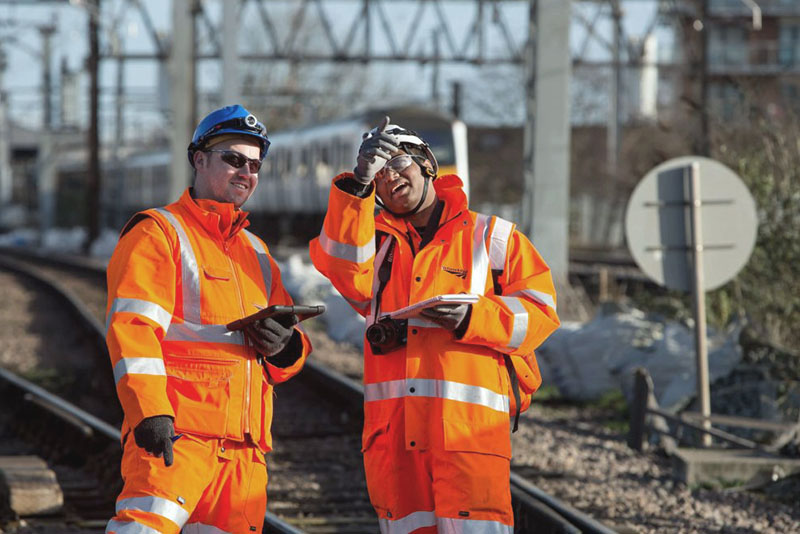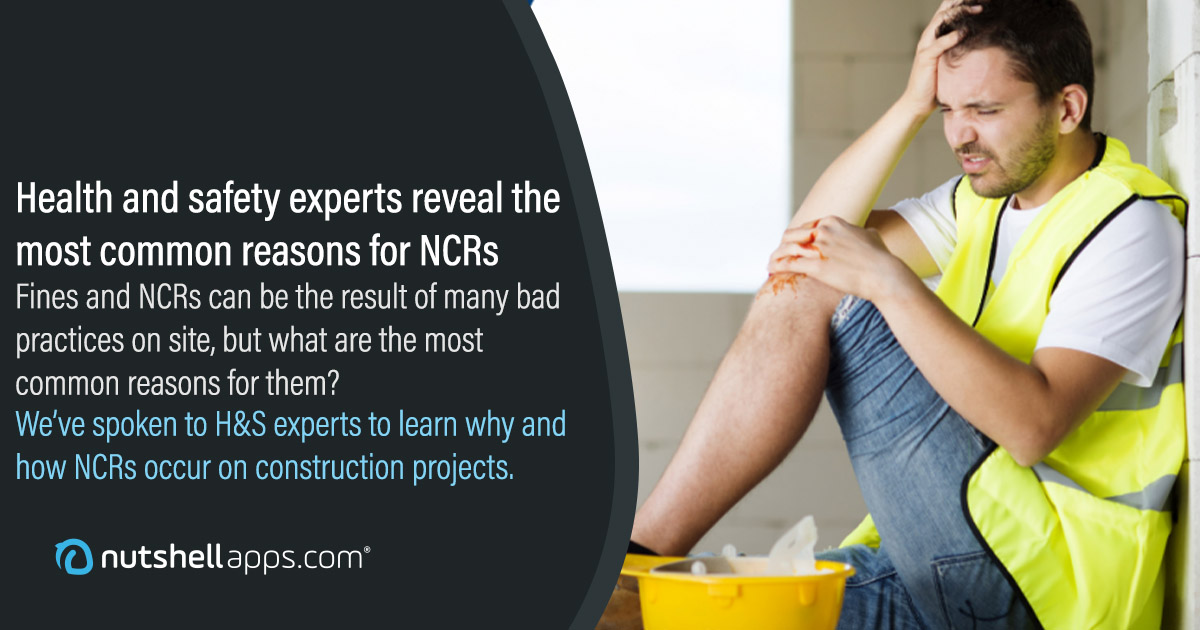We’ve spoken to experienced Health and Safety managers to learn the most common reasons construction firms are slapped with fines and NCRs and, more importantly, what you can do to prevent them.
For every construction and engineering project, there’s a stringent set of codes and regulations designed to keep people safe before, during, and after the scheduled work has taken place. If these aren’t followed, penalties will be issued as a way of righting any wrongdoing, and deterring others from making the same mistakes.
The prospect of receiving penalties like a fine or NCR strikes fear into the heart of Compliance and Health and Safety Managers everywhere. But what are the most common reasons for these punishments and what can we do to make sure we aren’t on the receiving end?
What is an NCR in construction?
An NCR, or non-conformance report (sometimes described as a non-compliance report), is issued to address specific deviations from a plan or process. It often involves falling below the expected and required standard, and the organisation in question must take steps to address the non-conformance to move forward.
NCRs aren’t exclusive to construction, as they can be issued in any environment where standards and quality management exist, but they can be particularly devastating on construction projects given the many moving parts and costs associated with corrections and delays, not to mention the massive fines.
NCRs will often follow an audit, which could be scheduled or random. Audits also often happen right after an accident or incident, so if failing to follow the process contributed to the deviation, it will more than likely be unearthed during an audit, which will lead to a fine or NCR.
In 2019/20, a whopping £35.8 million in fines were issued to duty holders found guilty of health and safety offences in, with the average fine per case being £110,000.
For Health and Safety and Compliance Managers, being issued an NCR can be a serious problem. This is why companies take steps to ensure their reporting tools, data processing and admin, and quality management systems help promote best practices, and may even identify potential NCRs internally before an audit.
How do NCRs tend to happen?
A lot of things can go wrong on a construction project, so sometimes it’s helpful to think about people and processes. People are of course responsible for everyday actions, carrying out safe work with safe behaviours, and they are guided by processes that have been set out either by the planner, the person in charge, or the regulator.
If there’s a non-conformance, it’s either down to a plan or process being incorrect, or a person not following that plan or process properly.
In construction, this often means something has been built that doesn’t fit the specification of the design drawings, the inspection and test plan hasn’t been followed, quality management and documentation procedures weren’t followed, activity-specific documentation wasn’t produced or is insufficient, or there’s been a design failure.
Those are the best case scenarios. The worst case scenario is that there’s been a serious accident or someone has been killed as a result of not following correct procedure, or the company has failed to set out a procedure at all, which has resulted in an incident.
There were 111 workers killed at work in 2020. Overall, 693,000 people sustained an injury at work, with 65,427 of these injuries reported under RIDDOR.
These are all outcomes we’re trying to prevent, but what mistakes and failings in the planning and delivery process lead to these outcomes and subsequent fines and NCRs? We’ve gathered the expert opinions of senior Health and Safety professionals to give you insights that can prevent penalties and NCRs, and may even save someone’s life.
1. Staff aren’t filling in or submitting reports
Reporting is crucial at every stage of the project, from scoping initial plans and build work, to daily inspections and snag reports, to safety-critical reporting like close calls and near misses. If staff aren’t filling out all the reports they need to, or aren’t submitting them promptly enough to take action, this can severely hamper the project as well as increase risk.
It’s paramount that staff know exactly which reports fall within their daily and weekly duties, how to complete and submit these, why they’re doing this reporting, and what the ramifications are of not doing it.
Workers may not know which reports sit within their remit, or may even see some reports as distractions or blockers to their daily duties. Remind staff that safety and high-quality work is always the priority, and this can only be achieved through good reporting. A stitch in time saves nine, or in this case could save lives.
Ideally this information is covered in the onboarding/induction process, so staff know their obligations from day one. But if you’re not satisfied with this, put together a user adoption strategy to help workers understand when and how to fill out reports, and how to submit them. You could even gamify adoption to incentivise good reporting practices.
2. Reports are missing data
Staff may be filling in the right reports, but are leaving sections blank either due to lack of knowledge or training on the matter, not knowing what or which data needs to be entered, or simply they’ve become lazy and no longer see the importance of submitting a full report. You could call it lazy, but reporting fatigue is also a very real thing and something you need to keep an eye out for – that’s why spot checks and reporting workshops are a good idea.
While missing data sometimes gets spotted before it leads to something sinister, because gaps in plans and documentation are clear to see, you’ll need to spend time and resources chasing this data down or redoing the report. That’s if you’re on the ball of course, as inaction will probably lead to something sinister, either a project failure, a safety risk, or a fine or NCR.
Emphasise good reporting practices by exploring individual report fields, what data needs to be collected and why, as well as the impact of not collecting this particular data. True accountability stems from appreciating the value of reporting and being considerate of the outcomes of not reporting, so emphasise both of these in turn.
3. Reports have bad/incorrect data
Bad or inaccurate data can be a real problem because it tends to creep up on you. With missing data, you can sometimes identify that you don’t have sufficient information, but bad data often isn’t identified until the mistake is made. Bad data in the planning stage leads to design failures, while bad daily reporting can impact work delivery and safety on site.
Even if the data is technically correct, it may not be recorded in the optimal format for processing, which leads to delays and additional manual interpretation. Encouraging your workforce to submit data in a uniform, standardised format can be even harder than convincing them to fill out the report in the first place; you aren’t only asking for high-quality data, you’re also asking for it to be recorded in a very specific way.
This is almost impossible on paper, unless every field is accompanied by a demo, but even then there’s no guarantee; once pen hits paper, you can’t control what happens from there. Digital reporting tools are the only way to physically prevent non-uniform data from being submitted, forcing the worker to take action and make the correction before submitting.
Nutshell’s suite of construction apps has data validation rules, enabling you to control the data that’s being submitted in each field by length, format, location, or even timeframe. There are also approval steps to prevent reports from being finalised until the data has been signed off by a manager or person in charge.

Construction giant Murphy recently deployed 3 mobile apps to replace their paper frontline reporting process.
Find out how they did it
4. Bad/inefficient data admin
Bad reporting practices are responsible for a large portion of construction fines and NCRs, but the strength of your reporting is of course dependent on the efficiency of your data processing and administration. Even good reporting data needs to be processed timely and efficiently to ensure safe and high-quality delivery of work.
The administration process can be spotty even in the most well-organised firms, especially if it happens on paper. When a report has been filled in, how long is it before that’s submitted? Who is it passed on to? How long does it take to get to back-office from there? When it’s at the office, what’s the workflow to process that data? Is it being done manually and do you have quality control to ensure no manual processing errors? How long until this processed data leads to actions?
You need to critique each step of your admin process and look for opportunities to streamline. Keep an eye out for backlogs with your admin staff as these can quickly bottleneck a project, or increase risk. You may need to introduce a priority system to process safety-critical data before all else, or consider overhauling your reporting process to ensure processing happens at the same pace as reporting, otherwise falling behind is inevitable.
5. Gaps in the induction/onboarding process
Safe and efficient work starts with the onboarding process. We’ve already explored how it’s important to introduce reporting duties and best practices during the onboarding process, but keeping track of training and competencies, or rather not keeping track of them, is one of the main reasons construction firms are slapped with fines and NCRs.
At any point you need to be able to identify which site workers are capable and competent to work on a certain project. Failure to do so will make it more difficult to plan scheduled works, as you won’t know which workers to assign and which aren’t qualified.
Worst-case scenario, a site worker is involved in a project where they lack the skills and competencies, which isn’t only illegal but could result in a serious accident.

Craig Boorman is Director at The Bradley Group, a Health and Safety training company, and he agrees that gaps in competencies and training are putting site workers at risk.
“Common reasons for fines and NCRs are not vetting contractors properly, and poor or no site OHS inspection regimes that would pick up work that’s not being done safely.
“It’s startling how often we find companies not giving workers enough training to make sure they understand what’s required.”
There needs to be a full audit trail throughout the induction process to keep track of training received, qualifications, and competencies. This may introduce an extra checklist to the induction process, likely for management-level staff to record this data, but this is mission-critical information that will need to be realised at some part of the project anyway, so may as well be recorded during onboarding.
The knock-on effect is that scheduled work can be planned far quicker and easier, with no ambiguity over who’s qualified and whether the work is safe.
With 7,075 notices issued by HSE in 2019/20, it’s no wonder the risk of fines and NCRs is the biggest fear experienced by Health and Safety and Compliance managers. Now you know what to look out for, making changes to improve reporting and data processing can go a long way in navigating these pitfalls, penalties and safety risks on your next construction project.

All your Health and Safety forms, reports, inspections and compliance checklists, in a nutshell…
Learn how Nutshell Apps streamlines reporting and administration to reduce your risk of fines and NCRs

